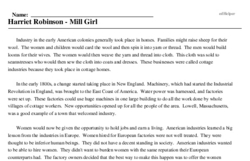Harriet Robinson - Mill Girl
Industry in the early American colonies generally took place in homes. Families might raise sheep for their wool. The women and children would card the wool and then spin it into yarn or thread. The men would build looms for their wives. The women would then weave the yarn and thread into cloth. This cloth was sold to seamstresses who would then sew the cloth into coats and dresses. These businesses were called cottage industries because they took place in cottage homes.
In the early 1800s, a change started taking place in New England. Machinery, which had started the Industrial Revolution in England, was brought to the East Coast of America. Water power was harnessed, and factories were set up. These factories could use huge machines in one large building to do all the work done by whole villages of cottage workers. New opportunities opened up for all the people of the area. Lowell, Massachusetts, was a good example of a town that welcomed industry.
Women would now be given the opportunity to hold jobs and earn a living. American industries learned a big lesson from the industries in Europe. Women hired for European factories were not well treated. They were thought to be inferior human beings. They did not have a decent standing in society. American industries wanted to be able to hire women. They didn't want to burden women with the same reputation their European counterparts had. The factory owners decided that the best way to make this happen was to offer the women wages high enough to give the jobs a higher standing among the people.




